Abstract
During the growth of selenium (Se)-deficient seedlings of Vigna radiata, exposure to mimosine [2-amino-3-(3-hydroxy-4-oxo-1H-pyridin-1-yl)-propanoic acid], a nonprotein plant amino acid, effectively mitigated stress at 0.1 mM, as reflected in enhancement of growth and efficiency of mitochondrial functions. Since the changes in the seedlings elicited by exposure to mimosine were similar to those effected by Se at an optimal exposure level of 0.75 ppm (Sreekala et al., Biol Trace Elem Res 70:193–207, 1999), the uptake of Se and that of mimosine itself was individually studied in the respiring mitochondria of Se-deficient seedlings (−Se-stressed group) in comparison with those exposed to mimosine during growth at 0.1 mM (Mim 0.1 group). In both groups, the mitochondrial uptake of 75Se at 10 μM added \({\text{Na}}^{{75}}_{2} {\text{SeO}}_{{\text{3}}} ,\) increased linearly up to 2 min, attaining steady-state levels thereafter. Uptake levels were 2.3-fold higher in the Mim 0.1 group than in the −Se-stressed group. Double-reciprocal plots of mitochondrial 75Se uptake against 2–20 μM \( {\text{Na}}^{{75}}_{2} {\text{SeO}}_{{\text{3}}} \) in the medium were nonlinear and negative cooperative effects during the uptake were confirmed by Scatchard plots, whereas Hill coefficients were 0.8 and 0.85 for the two groups. Mitochondrial uptake of mimosine, at added levels of 25 or 50 μM, increased linearly up to 1 min and decelerated thereafter. Initial uptake levels of mimosine at 1 min were higher by 6.5-fold at 25 μM and 4-fold at 50 μM in the Mim 0.1 group than those in the −Se-stressed group. Initial uptake levels with added mimosine up to 50 or 100 μM yielded nonlinear double-reciprocal plots; and kinetic analyses at 5 to 50 μM revealed the prevalence of positive cooperativity in the −Se-stressed group and negative cooperativity in the Mim 0.1 group. Involvement of active thiol groups in the uptake of both Se and mimosine were indicated by inhibition studies. Evidence presented for mimosine mediated increase in mitochondrial Se uptake and cooperative interactions thereof underscores the metabolic significance of mimosine.











Similar content being viewed by others
References
Laloi M (1999) Plant mitochondrial carriers. An overview. Cell Mol Life Sci 56:918–944
Fernie AR, Carrari F, Sweetlove LJ (2004) Respiratory metabolism: glycolysis, the TCA cycle and mitochondrial electron transport. Curr Opin Plant Biol 7:254–261
Douce R, Aubert S, Neuburger M (1997) Metabolite exchange between the mitochondrion and the cytosol. In: Dennis DT et al (eds) Plant metabolism. Addison Wesley Longman, Essex, pp 234–251
Bernardi P (1999) Mitochondrial transport of cations: channels, exchangers, and permeability transition. Physiol Rev 79:1127–1155
Palmieri F, Bisaccia F, Capobianco L, Dolce V, Fiermonte G, Iacobazzi V, Indiveri C, Palmieri L (1996) Mitochondrial metabolite transporters. Biochim Biophys Acta 1275:127–132
Porter RK (2000) Mammalian mitochondrial inner membrane cationic and neutral amino acid carriers. Biochim Biophys Acta 1459:356–362
Palmieri F, Picault N, Palmieri L, Hodges M (2004) Plant mitochondrial carriers. In: Day DA, Millar AH, Whelan J (eds) Plant mitochondria: from genome to function. Advances in photosynthesis and respiration, vol 17. Springer, Dordrecht, pp 247–276
Lalitha K, Rani P, Narayanaswami V (1994) Metabolic relevance of selenium in the insect Corcyra cephalonica. Uptake of 75Se and subcellular distribution. Biol Trace Elem Res 41:217–233
Rani P (1995) Relevance of selenium in mitochondrial functions, glutathione and hydroperoxide metabolism in the insect Corcyra cephalonica. Ph.D. Thesis, IIT Madras, India
Rani P, Lalitha K (1996) Evidence for altered structure and impaired mitochondrial electron transport function in selenium deficiency. Biol Trace Elem Res 51:225–234
Lalitha K, Easwari K (1995) Kinetic analysis of 75selenium uptake by mitochondria of germinating Vigna radiata of different selenium status. Biol Trace Elem Res 48:67–89
Sreekala M, Santosh TR, Lalitha K (1999) Oxidative stress during selenium deficiency in seedlings of Trigonella foenum-graecum and mitigation by mimosine. Part I. Hydroperoxide metabolism. Biol Trace Elem Res 70:193–207
Lalitha K, Rajendra Kulothungan S (2006) Selective determination of mimosine and its dihydroxypyridinyl derivative in plant systems. Amino Acids 31:279–287
Ikuma H, Bonner WD (1967) Properties of higher plant mitochondria. I. Isolation and some characteristics of tightly-coupled mitochondria from dark-grown mung bean hypocotyls. Plant Physiol 42:67–75
Neuburger M, Journet EP, Bligny R, Carde JP, Douce R (1982) Purification of plant mitochondria by isopycnic centrifugation in density gradients of Percoll. Arch Biochem Biophys 217:312–323
Gornall AG, Bardawill CJ, David MM (1949) Determination of serum proteins by means of the biuret reaction. J Biol Chem 177:751–766
Oyama VI, Eagle H (1956) Measurement of cell growth in tissue culture with a phenol reagent (Folin–Ciocalteu). Proc Soc Exp Biol Med 91:305–307
Lehninger AL, Rossi CS, Greenawalt JW (1963) Respiration-dependent accumulation of inorganic phosphate and Ca ions by rat liver mitochondria. Biochem Biophys Res Commun 10:444–448
Neet KE (1983) Contemporary enzyme kinetics and mechanisms. Methods Enzymol 64:267–319
Sreekala M, Lalitha K (2001) Kinetic analyses of mitochondrial 75selenium uptake in Trigonella foenum-graecum seedlings exposed to selenium and mimosine. Biol Trace Elem Res 79:271–285
Stadtman TC (1990) Selenium biochemistry. Annu Rev Biochem 59:111–127
Chance B (1977) Electron transfer: pathways, mechanisms, and controls. Annu Rev Biochem 46:967–980
Denton RM, McCormack JG (1985) Physiological role of Ca2+ transport by mitochondria. Nature 315:635–641
DeSantis A, Arrigoni O, Palmieri F (1976) Carrier-mediated transport of metabolites in purified bean mitochondria. Plant Cell Physiol 17:1221–1233
Jung DW, Laties GG (1979) Citrate and succinate uptake by potato mitochondria. Plant Physiol 63:591–597
Chappell J, Beevers H (1983) Transport of dicarboxylic acids in castor bean mitochondria. Plant Physiol 72:434–440
Vivekananda J, Beck CF, Oliver DJ (1988) Monoclonal antibodies as tools in membrane biochemistry. Identification and partial characterization of the dicarboxylate transporter from pea leaf mitochondria. J Biol Chem 263:4782–4788
McIntosh CA, Oliver DJ (1992) Isolation and characterization of the tricarboxylate transporter from pea mitochondria. Plant Physiol 100:2030–2034
Genchi G, Spagnoletta A, De SA, Stefanizzi L, Palmieri F (1999) Purification and characterization of the reconstitutively active citrate carrier from maize mitochondria. Plant Physiol 120:841–848
Picault N, Palmieri L, Pisano I, Hodges M, Palmieri F (2002) Identification of a novel transporter for dicarboxylates and tricarboxylates in plant mitochondria. Bacterial expression, reconstitution, functional characterization, and tissue distribution. J Biol Chem 277:24204–24211
Lancar-Benba J, Foucher B, Saint-Macary M (1996) Characterization, purification and properties of the yeast mitochondrial dicarboxylate carrier (Saccharomyces cerevisiae). Biochimie 78:195–200
Indiveri C, Tonazzi A, Giangregorio N, Palmieri F (1995) Probing the active site of the reconstituted carnitine carrier from rat liver mitochondria with sulfhydryl reagents. A cysteine residue is localized in or near the substrate binding site. Eur J Biochem 228:271–278
Cavalieri AJ, Huang AHC (1980) Carrier protein-mediated transport of neutral amino acids into mung bean mitochondria. Plant Physiol 66:588–591
Walker GH, Sarojini G, Oliver DJ (1982) Identification of a glycine transporter from pea leaf mitochondria. Biochem Biophys Res Commun 107:856–861
Hoyos ME, Palmieri L, Wertin T, Arrigoni R, Polacco JC, Palmieri F (2003) Identification of a mitochondrial transporter for basic amino acids in Arabidopsis thaliana by functional reconstitution into liposomes and complementation in yeast. Plant J 33:1027–1035
Burk RF (1983) Biological activity of selenium. Annu Rev Nutr 3:53–70
Dolinska M, Albrecht J (1998) l-Arginine uptake in rat cerebral mitochondria. Neurochem Int 33:233–236
Molina M, Segura JA, Aledo JC, Medina MA, Nunez de Castro I, Marquez J (1995) Glutamine transport by vesicles isolated from tumour-cell mitochondrial inner membrane. Biochem J 308(Pt 2):629–633
Medina D, Lane H, Oborn CJ (1982) Uptake and localization of selenium-75 in mammary epithelial cell lines in vitro. Cancer Lett 15:301–310
Behne D, Hilmert H, Scheid S, Gessner H, Elger W (1988) Evidence for specific selenium target tissues and new biologically important selenoproteins. Biochim Biophys Acta 966:12–21
Author information
Authors and Affiliations
Corresponding author
Rights and permissions
About this article
Cite this article
Lalitha, K., Kulothungan, S.R. Mimosine Mitigates Oxidative Stress in Selenium Deficient Seedlings of Vigna radiata. Part II: Mitochondrial Uptake of 75Selenium and Mimosine. Biol Trace Elem Res 118, 269–286 (2007). https://doi.org/10.1007/s12011-007-0032-x
Received:
Accepted:
Published:
Issue Date:
DOI: https://doi.org/10.1007/s12011-007-0032-x




